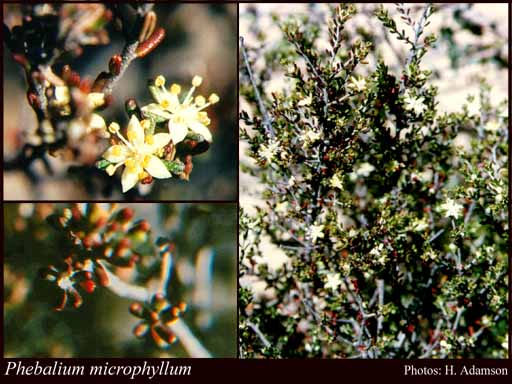- Reference
- Bull.Soc.Imp.Naturalistes Moscou 25 (2):159 (1852)
- Conservation Code
- Not threatened
- Naturalised Status
- Native to Western Australia
- Name Status
- Current
Upright, spreading shrub, 0.3-1.5 m high. Fl. white/cream, Jun to Sep. Sandy & clayey soils. Undulating plains.

Scientific Description
Shrub, spines absent, +/- cylindrical in cross-section, covered in hairs or scales, the hairs peltate (umbrella-like) scales. Leaves opposite, simple, 3-5 mm long, 1 mm wide, flat, the margins recurved, verrucose (warty), covered in hairs or scales, with peltate (umbrella-like) scales; stipular excrescences absent. Flowers in terminal, loose clusters (cymes or panicles); pedicels 3-6 mm long; calyx present, 2-2.5 mm long, verrucose (warty), covered in hairs or scales; corolla white or cream, petals five, 5-6.5 mm long, imbricate (overlapping), free, lepidote (with scales); stamens twice as many as petals, 5-5.5 mm long, smooth, glabrous; style 5-5.5 mm long, glabrous. Flowers in June, July, August and September. Occurs in the Eremaean and South-West Botanical Province, in the Murchison, Great Victoria Desert, Coolgardie, Avon Wheatbelt, Mallee, Esperance and Geraldton IBRA region(s).
Distribution
- IBRA Regions
- Coolgardie, Esperance Plains, Geraldton Sandplains, Great Victoria Desert, Mallee, Murchison.
- IBRA Subregions
- Eastern Mallee, Eastern Murchison, Fitzgerald, Lesueur Sandplain, Shield, Southern Cross, Western Mallee.
- Local Government Areas (LGAs)
- Coolgardie, Coorow, Dumbleyung, Esperance, Gnowangerup, Jerramungup, Kalgoorlie-Boulder, Kent, Kondinin, Lake Grace, Menzies, Ravensthorpe.